Zebra ET80/ET85
12-inch Intel Core-powered Windows tablet offers an impressive combination of performance, functionality, and ruggedness in a slender, ergonomic package that can work as a standalone tablet, a mounted tablet, or a laptop.
(by Conrad H. Blickenstorfer; photography by Carol Cotton)
The ET8x series represents Zebra's entry in the important segment of rugged tablet computers running Microsoft Windows on 12-inch screens. Designed to improve on-the-job productivity across multiple industries, the tablets bring light weight, ease of use, ample performance, and state-of-the art wireless technology to front-line workers that rely on mobile tech on the go, in vehicles, or at their desks. To that extent, the ET8x series can be purchased with detached rugged keyboards for either a tablet or a complete laptop experience.
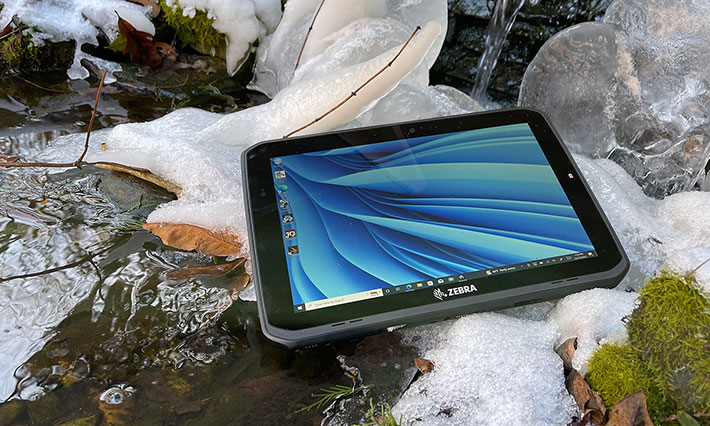
Unlike the smaller Zebra ET5x series that includes both Android and Microsoft Windows versions with or without mobile broadband and in two different display sizes, for now the ET8x consists of just the ET80 and the ET85 models, both running Windows, with the sole difference that the ET85 has cellular connectivity and the ET80 doesn't.
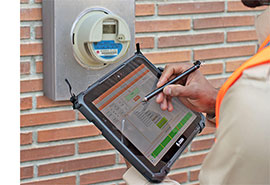 What is the ET8x series for? They are ruggedized tablet computers for the job, not as big and heavy as some rugged tablets, but definitely much tougher than consumer products. A Zebra representative said the goal was to make them just right for all-day, everyday business, inside and outside the four walls, tough but as light and mobile as possible.
What is the ET8x series for? They are ruggedized tablet computers for the job, not as big and heavy as some rugged tablets, but definitely much tougher than consumer products. A Zebra representative said the goal was to make them just right for all-day, everyday business, inside and outside the four walls, tough but as light and mobile as possible.
This is actually often a predicament for business and enterprise customers deciding on what products to buy. Consumer tablets are inexpensive and familiar, and so there is the temptation to go with them and stick them in a case for a bit of extra protection. That is rarely the best way to go. It's better to get something that's built for the job. It costs less in the long run because ruggedized tech is less likely to break down and cause down-time, repairs, and replacement costs.
Zebra's target customers for the ET8x series are first responders, field service technicians, manufacturing line workers and the like, and so we think it comes down to an emphasis on ergonomics, design that fits in, handy size and weight, as much easy mobility as possible, and making available the kind of accessories and options likely needed in these sectors.
"Zebra customer" positioning
Zebra determined that its target customers like products that, by and large, capture the elegant look and feel of consumer tablets, but in packages that are less fragile and more focused on the real-world requirements of work. As a result, instead of going for the traditional hard-core "rugged" look, Zebra chose the consumer tablet design language with flush all-glass front and a thin, monolithic shape and profile. The 12-inch ET80/ET85 has a 12.1 x 8.9 inch footprint, is barely more than half an inch thick, and weighs about 2.8 pounds — larger and heavier than a 12-inch consumer tablet, but still handy enough to fit in just about anywhere.
Externally, the ET80/ET85 does pay homage to the older and now discontinued 12-inch Zebra Xplore R12 tablet in one design element — the chamfered corners that gave the R12 its unique look. The R12 machine was originally designed by tablet PC pioneer Motion Computing. Motion was bought out by rugged tablet specialists Xplore Technologies, which, in turn, was acquired by Zebra. Here at RuggedPCReview.com we liked the R12 a lot. It was a great design, and also the one that pioneered the switch from mSATA to PCIe solid state disks in rugged tablets, making it the highest performance rugged tablet of its time.
The new ET80/ET85 is therefore the successor of the R12, and here is how the two differ from one another:
|
|
New vs Old
|
Zebra ET80/ET85
|
Zebra Xplore R12
|
|
|
|
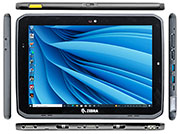
|
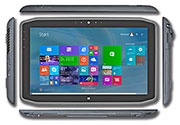
|
|
|
Launched
|
2022
|
2014
|
|
|
Processors
|
11th gen Intel Core (Tiger Lake)
|
7th gen Intel Core (Kaby Lake)
|
|
|
Display
|
12.0-inch, 2160 x 1440 (216 ppi)
|
12.5-inch, 1920 x 1080 (176 ppi)
|
|
|
Display aspect ratio
|
3 : 2
|
16 : 9
|
|
|
Display luminance
|
800 nits
|
1000 nits
|
|
|
RAM Memory
|
8 or 16GB LPDDR4x-4266
|
4 or 8GB
|
|
|
Fan
|
not needed
|
yes
|
|
|
Size
|
12.1 x 8.9 x 0.6 inches
|
12.9 x 8.2 x 0.75 inches
|
|
|
Volume
|
64.6 cubic inch
|
79.3 cubic inch
|
|
|
Weight
|
2.80 lbs
|
2.95 lbs
|
|
|
Operating temp.
|
-4°F to 140°F
|
-4°F to 140°F
|
|
|
Operating drop
|
4 feet (5 feet in boot)
|
4 feet
|
|
|
Sealing
|
IP65
|
IP54
|
|
|
Battery
|
40 watt-hours ("11 hours")
|
45 watt-hours ("9 hours")
|
|
|
Cameras
|
Full HD front, 13 mp back
|
2mp front, 8 mp back
|
|
|
Wi-Fi
|
WiFi 6E 802.11ax R2
|
Wireless AC 8260
|
|
|
Bluetooth
|
v5.2 + Audio LE Class 1
|
v4.2
|
|
|
WAN
|
5G
|
4G LTE
|
Processor — The old R12 was a no holds barred performance powerhouse. Given Zebra's "enterprise" focus that precluded a noisy and potentially troublesome fan, Zebra's engineers were a bit more limited in how much horsepower they could put into the ET8x series.
Unlike the Intel Atom-based Zebra ET5x series tablets, the ET8x is based on genuine Intel Core processors. However, they are of the lower-power 7/15 watt variety and not of the performance-oriented 12/28 watt versions used by most performance-oriented rugged tablets.
Display — We liked the old R12's IPS display a lot, both for its generous 12.5-inch size that worked better for complex Microsoft Windows software than smaller tablets and its full HD 1920 x 1080 resolution. The ET8x series is even sharper with 2160 x 1440 resolution. That's 50% more pixels and substantially higher pixel density. Brightness is down a bit, from 1000 to 800 nits. But we prefer the ET8x's 3:2 display aspect ratio over the old R12's 16:9.
Ruggedness — For its time, the old R12 was quite thin and light, but the new ET8x series is thinner and lighter and more rugged in several areas. IP65 ingress protection without port covers beats IP54 by a mile, and with an optional boot, the new ET8x can handle 5-foot drops.
Wireless — Fast, reliable wireless performance is absolutely crucial in enterprise deployments challenged by low-signal areas on the road and "dead zones" in the warehouse. Here, the ET8x shines with WiFi 6E 802.11ax R2 LAN, 5G mobile broadband, and CBRS support that allows private LTE networks. And as far as positioning goes, the new dual band L1 + L5 tablets now support BeiDou/Compass in addition to the US GPS, European Galileo and Russian GLONASS. More satellites means better coverage in difficult geographic settings.
Add to that the new ET8x series' lower weight, lesser volume, much improved cameras plus all the additional goodness Zebra has baked into their new 12-inch enterprise tablets, and you have a most worthwhile successor to the old R12.
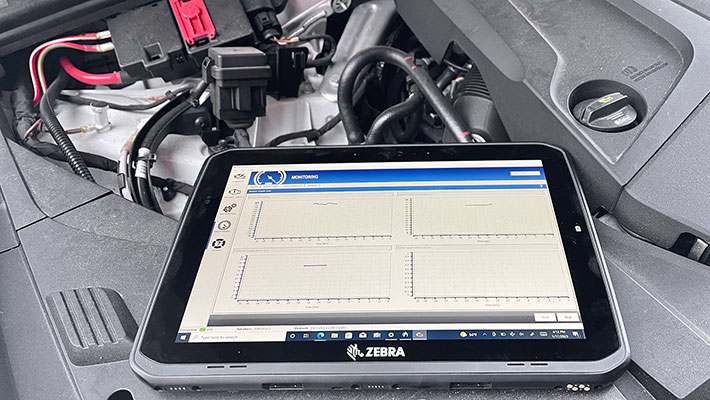
Design, look, and feel — elegant utility
In its two-pronged quest for an enterprise tablet design that takes advantage of the popularity and familiarity of consumer tablets and can handle the use and abuse of operation in challenging environments, Zebra succeeded. In fact, they succeeded even better with the ET8x series than with the smaller ET5x designs that looked almost a bit too generic. Not least due to its chamfered corners, the ET8x series has its own distinct personality.
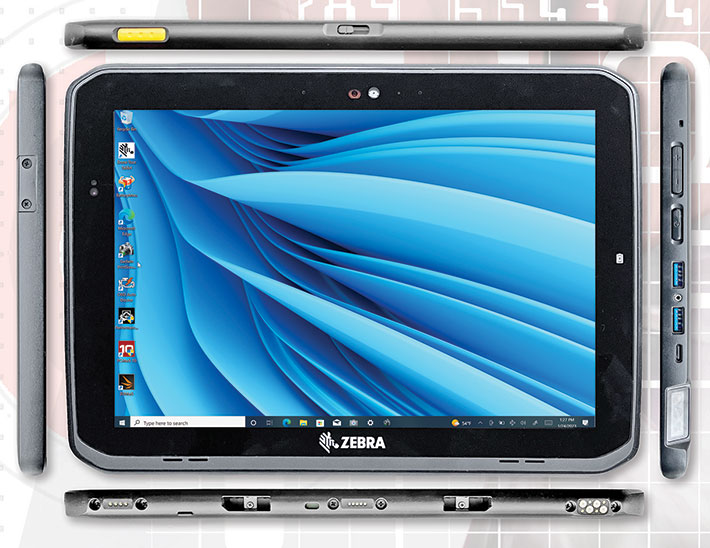
Enterprise tablets, of course, are tools for work. Functionality, reliability and practicality matter. Here we'd like to have seen the black plastic housing a bit grippier and more textured, so as to make it less slippery than most consumer tablets are. We are talking almost three pounds here, and though the ET8x is rugged, no one wants to have their tablet slip out of their hands. The small power and volume buttons on the right side have embossed labels, but having on/off and volume right next to each other isn't optimal.
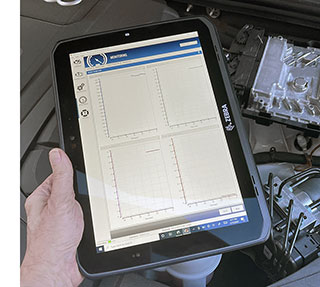 There's really no need to mark ports, and they aren't. And with the advent of USB-C that can do almost anything, there's no more need to have all those separate plugs for all the industry standard connectors that may or may not be required on a job. The ET8x series comes with just two USB-A ports and one USB-C. If more is needed, there are docks and adapters.
There's really no need to mark ports, and they aren't. And with the advent of USB-C that can do almost anything, there's no more need to have all those separate plugs for all the industry standard connectors that may or may not be required on a job. The ET8x series comes with just two USB-A ports and one USB-C. If more is needed, there are docks and adapters.
The ET8x series, like most modern tablets, has front and rear cameras. The one in the front doesn't need a notch like some smartphones have; there's enough of a bezel around the LCD to place the camera. Both the front and the rear camera have manually operated privacy shutters so bad actors can't peek through them. The battery is externally accessible and replaceable.
There's a large bezel area around the actual LCD screen. You can actually hold this tablet without the screen misinterpreting it for a touch operation, as is the case with all those new bezel-less smartphones and tablets. And while the glass front extends over almost the entire tablet, the plastic housing does provide protection around the entire perimeter. It all makes sense and ET8x users will appreciate this well thought-out design.
And in case you wonder if Zebra managed to put the customary industrial-grade scanner into such an impressively slender design without having to resort to a "scanner bulge," Zebra pulled it off. Zebra's own SE4107 scan engine is built right in, at a slight angle for ergonomic reasons.
The battery compartment — shown below open with and without the battery — is sealed by a flexible plastic cover that snaps on. It is unlikely that it'll ever work itself loose accidentally. Do keep an eye on the rubber pressure seal that's molded onto the inside of the compartment cover.
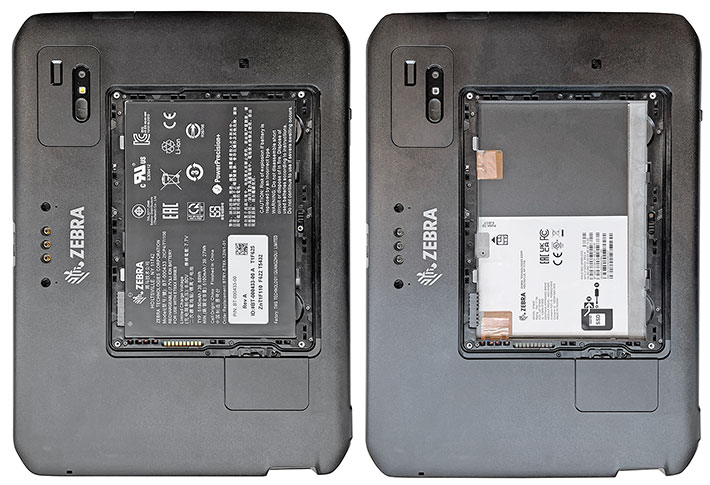
The very slender (3/16th-inch) battery itself is a rechargeable Lithium-Ion Polymer design rated at 7.7 Volt, 5.18 Ahr, for a total of 39.8 watt-hours. As shown above, the battery needs to be removed in order to get at the ET85 tablet's nano-SIM slot (there's also an eSIM).
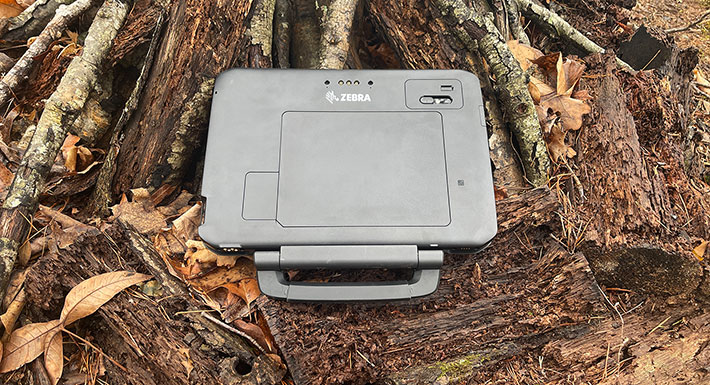
The (optional) keyboard for 2-in-1 functionality
When you look at the ET8x page on Zebra's website, the company states right in the opening paragraph: "Available as a standalone tablet, or with a detachable keyboard to provide a true 2-in-1, the ET80 and ET85 offer the flexibility your workforce demands." And the ET8x product sheet's title also is "ET8x 2-in-1 Tablets."
Why that? After all, the purpose of a tablet computer is having a device without a keyboard to weigh you down. "Pure" tablets without physical keyboards indeed do work great for consumer tablets such as iPads or the Android tablets. That's because the operating environment on those tablets — iOS and Android — were specifically developed for touch, and the software was developed specifically for touch as well.
It can be a different story with Microsoft Windows, which specifically was developed decades ago for use with a mouse. Windows has become touch-friendlier over the years, but Windows and Windows software often works better with a keyboard and a trackpad or a mouse. And that's why Zebra offers a very nicely integrated and highly functional keyboard for the ET8x series.
Below you can see how an ET8x tablet looks when used with its optional detachable keyboard — it becomes a laptop with an integrated carry handle!
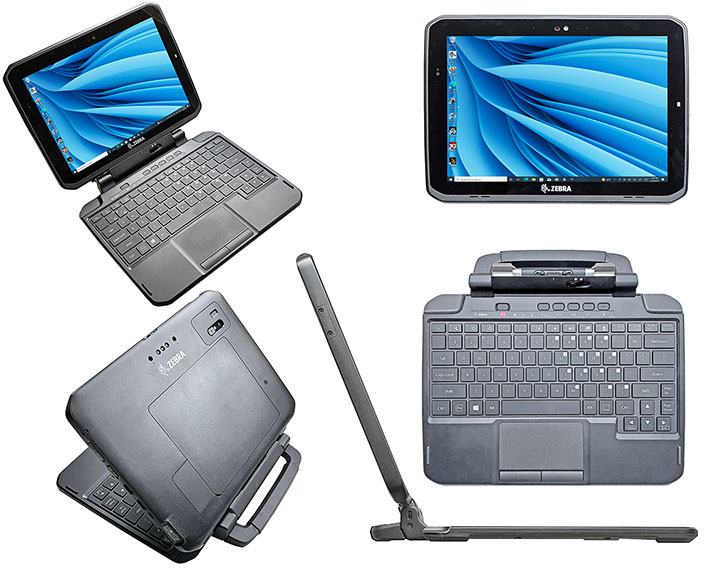
How does it work? Going from tablet to laptop simply means gliding the tablet into two hooks on the very sturdy hinge on the optional keyboard. A spring-loaded mechanism automatically locks the tablet into place. And since this is a physical and not a wireless connection, the keyboard works instantly and reliably — no waiting for Bluetooth to hopefully connect (and stay connected).
And note that Zebra really thought all that through. While many such detachable keyboards are thick and heavy and offer additional ports, Zebra's emphasis was on making theirs as light, portable and ergonomic as possible. Look at how thin it is! One of the inherent problems with tablet 2-in-1s is that the tablet part — which unlike in a notebook includes the computers and the battery — tends to be heavy, making the 2-in-1 assembly unstable and prone to tipping over. Zebra cleverly addressed that in several ways. First, the integrated handle provides extra stability. Second, the hinge angle is limited so that the overall center of gravity is never past the tipping point. And third, for extra stability the handle can be pulled out another inch. Brilliant.
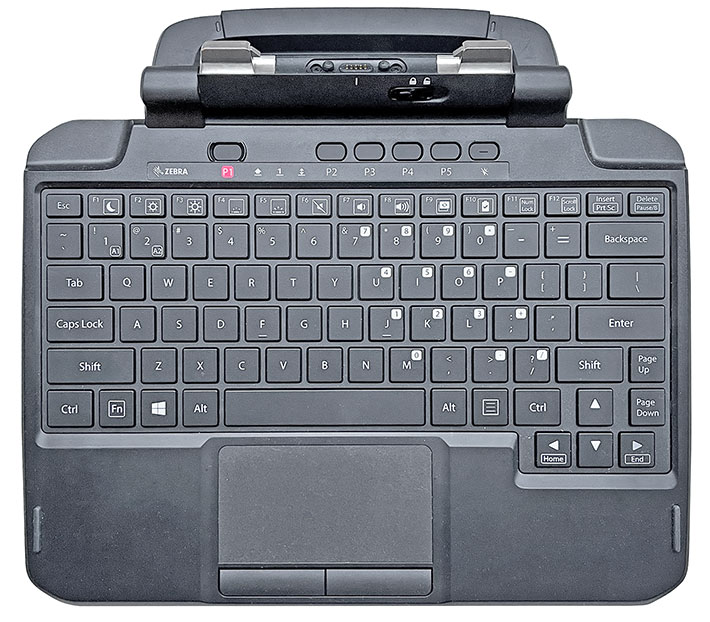
As for the keyboard itself, it is a full-scale "island-style" design like most laptop keyboards these days. The keys feel nice and firm with good tactile feedback. The thin type and white-on-black key icons look elegant. We've never been great fans of numeric keypad functionality integrated into the QWERTY layout, but it works (Fn + NumLock engages the keypad). Function labels are icon-style black on white, sometimes below and sometimes to the right of the default character of the key. The whole design looks and feels much like the standard Apple keyboard, which today is as much praised for its "look and feel" as the original IBM PC keyboard was at the dawn of personal computing.
The touchpad and mouse button design and size are like those of a standard laptop. There are two rectangular mouse keys, the pad area is slightly recessed. It uses capacitive multi-touch, works smoothly, and has just the right amount of stiction for precise movement. What is "stiction"? It's defined as "the friction that tends to prevent stationary surfaces from being set in motion."
The keyboard has an LED-based backlight that can be activated and toggled through six brightness settings via a function key combination. Backlight color can be changed to whatever you want via a Keyboard Backlight Control utility. The key backlighting is pleasant and clearly illuminates the keys in semi and full darkness, with minimal illumination bleed around the keys in the dark.
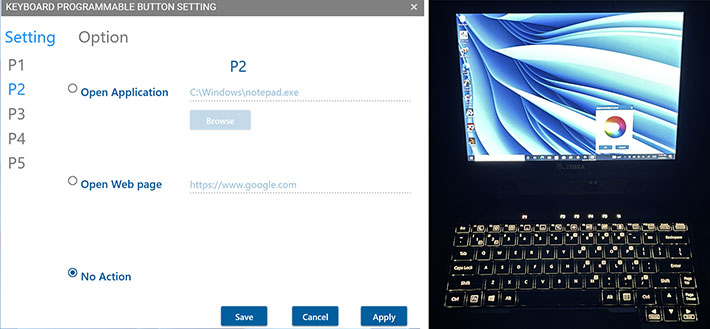
Zebra also made good use of the standard 12 function keys. In conjunction with the Fn key, they can engage blackout mode, do screen and key backlight brightness, audio off/up/down, set external display modes, bring up the battery info panel, and more. There are also five programmable keys to quickly open apps or web pages.
Overall, the ET8x series' optional keyboard is so good and so well integrated into the tablet that we can't think of any reason not to get it. It adds so much functionality to this platform that it's pretty much a (albeit rather pricey) must-have option.
And here are side views of the ET8x with the keyboard. Zebra claims that their 2-in-1 is more than than 35% thinner and 20% lighter than major 2-in-1 competitors with the same screen size.


Performance
Selecting the right processor for a tablet PC isn't easy, especially when it's for a tablet that needs to be as thin and light and handy as possible; not need a fan to remove the heat from a powerful processor; yet still capable of running Windows 10 or 11 fast enough for anticipated jobs.
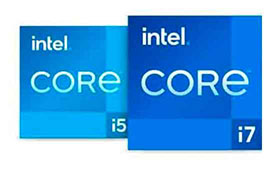 As is, Intel's 11th generation of Core processors, code named "Tiger Lake," turned out to be very well suited for mobile applications, providing a good balance between high performance and economical operation without generating more heat than a mobile device can reasonably dissipate. As a result, the majority of performance-oriented rugged tablets and laptops from Tier 1 vendors currently available are using "Tiger Lake" chips, and some have already moved on to 12th generation "Alder Lake" processors.
As is, Intel's 11th generation of Core processors, code named "Tiger Lake," turned out to be very well suited for mobile applications, providing a good balance between high performance and economical operation without generating more heat than a mobile device can reasonably dissipate. As a result, the majority of performance-oriented rugged tablets and laptops from Tier 1 vendors currently available are using "Tiger Lake" chips, and some have already moved on to 12th generation "Alder Lake" processors.
The table below shows the selection of three processors available to Zebra ET8x series customers. There isn't a great deal of difference between them. The two Core i5 chips, especially, are very close to each other, with the exception of some Intel technologies either baked in or not. Some applications and design need them or benefit from them, for others they are not necessary. The Core i7 option will offer noticeably higher performance due to higher clock speeds, 50% more Intel Smart Cache, and 96 instead of 80 graphics execution units.
|
Zebra ET80/ET85: Available Intel Core processor options (see full table)
|
|
Available ET80/ET85 CPUs
|
Intel Core i5
|
Intel Core i5
|
Intel Core i7
|
|
Model
|
1130G7
|
1140G7
|
1180G7
|
|
Cores/Threads
|
4/8
|
4/8
|
4/8
|
|
Clock TDP down/up
|
0.80/1.80 GHz
|
0.80/1.80 GHz
|
0.90/2.20 GHz
|
|
Max Turbo Speed
|
4.00 GHz
|
4.20 GHz
|
4.60 GHz
|
|
TDP down/up
|
7/15 watts
|
7/15 watts
|
7/15 watts
|
|
TDP-down
|
12 watts, 1.20GHz
|
12 watts, 1.10GHz
|
12 watts, 0.90GHz
|
|
Smart Cache
|
8MB
|
8MB
|
12MB
|
|
Integrated graphics
|
Iris Xe (80 EUs)
|
Iris Xe (80 EUs)
|
Iris Xe (96 EUs)
|
|
Graphics max speed
|
1.10 GHz
|
1.10 GHz
|
1.10 GHz
|
|
Relative CPU cost
|
1.10
|
1.00
|
1.38
|
|
Intel Stable Image Platform Program
|
No
|
Yes
|
Yes
|
|
Intel Total Memory Encryption
|
No
|
Yes
|
Yes
|
|
Intel Trusted Execution
|
No
|
Yes
|
Yes
|
|
Intel vPro
|
No
|
Yes
|
Yes
|
Do, however, note that there is an important and easily overlooked difference between the three chips above and the one that most of the rugged tablet and laptop competition is using. Zebra chose 1130G7, 1140G7 and 1180G7 chips, instead of the more common 1135G7, 1145G7 and 1185G7 processors inside most of competitors' models. What's the difference?
That would be processor speed, both maximum and maximum sustainable. The 1130/1140/1180 7/15 watt chip versions that Zebra uses can be kept nice and cool without a fan and with little passive cooling, but cannot generate as much performance as the 1135/1145/1185 12/28 watt chips in systems with fans and more mass for passive cooling.
So the chips are essentially identical, except for the maximum heat they are allowed to generate. The 12/28 watt chips can run at high clock speeds, generating higher performance, longer than the 7/15 watt chips. The flipside is that the heat generated by the 12/28 watt chips must be dissipated either actively with fans or passively with a heavy metal frame, or both. Zebra decided that a lighter, thinner and cooler-running fanless tablet design outweighed the slight performance hit they'd take by going with the 12/28 watt chips.
To see what kind of performance the Zebra ET8x tablet is capable of, we ran our 1130G7-powered evaluation ET85 through our standard benchmark suites. For comparison and to provide an idea where the ET8x fits in, we included benchmark results for one of Zebra's smaller ET5x tablet, and as well as for four other rugged tablet and 2-in-1 competitors we've tested and benchmarked in our lab.
The results are as follows:
|
Zebra ET85 Benchmarks and Comparisons
|
|
PERFORMANCE COMPARISON
|
Zebra
|
Zebra
|
Durabook
|
Durabook
|
Getac
|
RuggON
|
|
Model
|
ET85
|
ET56
|
R8
|
R11
|
K120
|
LUNA 3
|
|
Device type
|
Rugged 2-in-1
|
Rugged tablet
|
Rugged tablet
|
Rugged 2-in-1
|
Rugged 2-in-1
|
Rugged tablet
|
|
Screen size
|
12.0"
|
8.4"
|
11.6"
|
8.0"
|
12.5"
|
8.0"
|
|
Year tested
|
2023
|
2019
|
2023
|
2022
|
2021
|
2022
|
|
Processor Type: Intel
|
Core
|
Atom
|
Core
|
Core
|
Core
|
Core
|
|
Processor Model
|
i3-1130G7
|
x5-E3940
|
i7-1230U
|
i7-1255U
|
i7-1165G7
|
i5-1145G7
|
|
Processor Code
|
11th Tiger Lake
|
11th Tiger Lake
|
12th Alder Lake
|
12th Alder Lake
|
11th Tiger Lake
|
11th Tiger Lake
|
|
Thermal Design Power (TDP)
|
7/15 watts
|
9.5 watts
|
9/29 watts
|
15/55 watts
|
12/28 watts
|
12/28 watts
|
|
PassMark 6.1
|
5,534
|
1,447
|
5,603
|
11,000
|
6,585
|
3,955
|
|
PassMark 9.0
|
4,120
|
955
|
2,530
|
5,602
|
5,839
|
NA
|
|
PCMark 10 Overall
|
3,855
|
NA
|
3,341
|
5,359
|
5,148
|
3,680
|
|
PCMark 10 Essentials
|
8,116
|
NA
|
7,578
|
10,485
|
10,312
|
8,234
|
|
PCMark 10 Productivity
|
5,631
|
NA
|
5,198
|
7,248
|
6,935
|
5,788
|
|
PCMark 10 Digital COntent
|
3,402
|
NA
|
1,216
|
5,497
|
5,177
|
2,828
|
|
PCMark 10 Drive
|
1,040
|
NA
|
1,216
|
1,623
|
2,119
|
NA
|
|
PCMark 10 Battery
|
4:14 hrs
|
NA
|
3:08 hrs
|
5:32 hrs
|
NA
|
2:11 hrs
|
|
3DMark
|
888
|
NA
|
784
|
1,384
|
1,434
|
626
|
|
GeekBench 5 Single
|
1,291
|
NA
|
1,259
|
1,586
|
1,531
|
1,138
|
|
GeekBench 5 Multi
|
3,136
|
NA
|
3,535
|
5,747
|
4,831
|
3,087
|
|
GeekBench 5 Open CL
|
2,060
|
NA
|
2,470
|
14,618
|
14,736
|
5,223
|
|
CrystalMark
|
317,931
|
129,273
|
274,377
|
417,117
|
522,217
|
311,006
|
Interpreting benchmark results is never easy, and it's especially complicated when comparing different processor generations, or even different level processors within the same processor generation. And performance doesn't only depend on the processor. The type of RAM and, especially, storage can make a big difference. So what can we say based on the above benchmark results?
First, the Intel Core-based Zebra ET8x series is in an entirely different performance class than the smaller and Intel Atom-based Zebra ET5x series. The difference there is substantial. Which is okay as the two series do not have the same target customers and application requirements.
Second, Intel Core processors do generate a fair amount of heat, and that means that small, thin, fanless design comes at the cost of somewhat lower performance due to the cooler-running chips they must use, because they simply cannot dissipate as much heat as large systems with fans.
Third, it's difficult to compare the benchmark performance of Intel 11th and 12th generation systems because with the 12th generation Intel switched to a "hybrid" architecture that mixes "power" and "economy cores in much the same way that most smartphones do. We're just beginning to see the real-world implications of that design change.
And, finally, judging by our vast database of benchmark results, we'd estimate that systems with 11th gen 12/28 watt chips overall run about 10-15% faster than systems based on 7/15 watt chips.
In our day-to-day testing, the Zebra ET85 felt quick and responsive, and was up to any workload we threw at it.
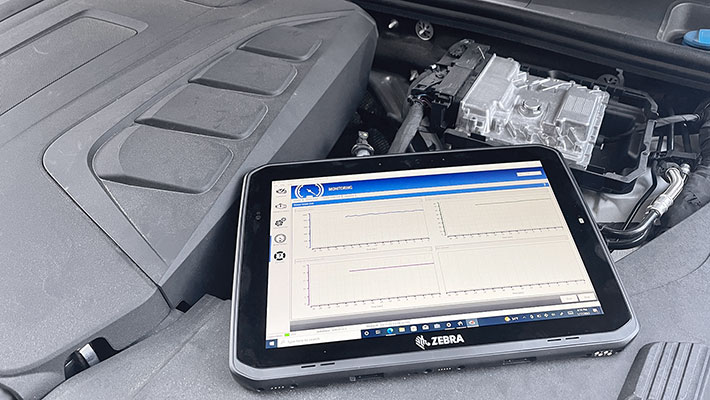
Battery life
Battery size, weight and life are always a big issue in mobile devices. And especially so in a device that needs to be as thin and light as possible. Battery technology has improved substantially, but not as quickly as processor and storage technology. As a result, it's still often a trade-off between size, weight, cost and battery life. How did Zebra handle the battery issue in the ET8x series?
First of all, the main battery is exchangeable and externally accessible. And Zebra also offers a second optional hot-swappable battery via an expansion back to significantly add to battery run time. That, of course, comes at the cost of some extra bulk and weight.
As is, the ET8x default battery packs 39.8 watt-hours. That's about the same as Apple's latest 12.9-inch-inch iPad Pro. People generally expect at least 10 hour battery life from an iPad, and we think expecting at least full-shift battery life from a modern Windows tablet is reasonable. But as a big Intel/Windows system, how does the ET8x series compare?
|
Zebra ET85 BatMon Power Draws (at idle)
|
|
Backlight level
|
Darkest
|
50%
|
Brightest
|
|
Max Battery
|
4.9 watts (8.1 hrs.)
|
5.3 watts (7.5 hrs.)
|
9.4 watts (4.2 hrs.)
|
|
Max Performance
|
5.4 watts (7.4 hrs.)
|
7.0 watts (5.7 hrs.)
|
11.8 watts (3.4 hrs.)
|
We used PassMark's BatteryMon to find out. With the Windows 10 slider moved all the way to "Best battery life" mode, and the screen brightness slider set to 0% we saw a stunningly a minimum of 4.9 watts, higher than we expected. With the backlight set to 50%" it was 5.3 watts, and with the backlight at 100% it rose all the way to 9.4 watts. Dividing the available 39.8 watt-hours of a fully charged battery by the lowest observed battery draw of 4.9 watts would indicate a theoretical battery life of 8.1 hours, just barely over a full shift, and less than the 11 hours in the ET8x series spec sheet.
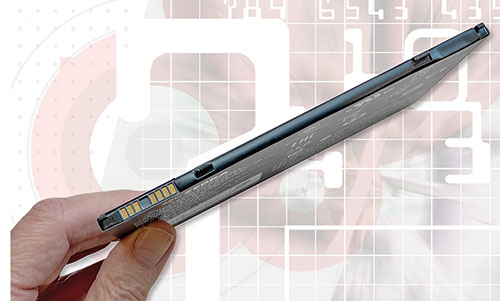 Putting the Windows 10 slider to "Best performance" and setting the backlight to 0%, minimum power draw was 5.4 watts, just a tad higher than in battery conservation mode. With the backlight set to the 50% level, it was 7.0 watts, and with the backlight at 100% 11.8 watts.
Putting the Windows 10 slider to "Best performance" and setting the backlight to 0%, minimum power draw was 5.4 watts, just a tad higher than in battery conservation mode. With the backlight set to the 50% level, it was 7.0 watts, and with the backlight at 100% 11.8 watts.
The optional secondary battery adds another 25.8 watt-hours, for a total of 66% more than just the standard battery alone. Depending on the type of workload, that may be needed to make it through a shift.
The usual caveat: benchmark power drawdown simply measures power draw of the device idling along. In real life use in the field, the tablet may go from periods of maximum load to going to sleep. Actual battery life can therefore vary dramatically.
Expansion backs and accessories
One of the advantages of dealing with a company the size of Zebra (2021 annual sales $5.63 billion) is that every product line will have plenty of extensions, expansions, accessories and optional gear of all sorts, all designed especially for that particular product.
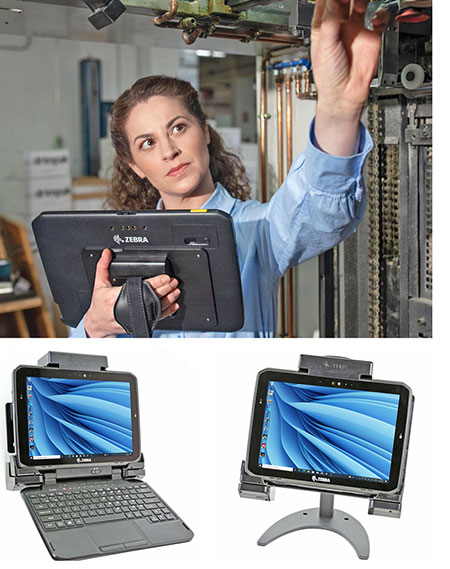 Examples are two expansion backs, one of which provides a slot for the extended battery and also a rotating handstrap that comes in handy when working with a fairly large 12-inch tablet (shown to the left). A second expansion pack adds a CAC Smartcard reader and also a slot for the extended battery.
Examples are two expansion backs, one of which provides a slot for the extended battery and also a rotating handstrap that comes in handy when working with a fairly large 12-inch tablet (shown to the left). A second expansion pack adds a CAC Smartcard reader and also a slot for the extended battery.
Both expansion packs can be used with a foldable kickstand so you can sit the table down on a table for easy reading and touch operation. And for touch, by the way, Zebra also offers an active, pressure-sensitive pen so users can take advantage of the wealth of Windows software that supports the active pen.
While pretty much all providers of rugged tablet hardware offer third party docks, Zebra has its own Zebra branded docks. The vehicle dock shown on the left adds USB and LAN ports, can use vehicle power, is IP65 sealed like the tablet, has a lock but is also easily released, and can be mounted in numerous ways via 75x75 and 100x100 VESA mounting patterns.
The office dock shown next to it adds USB and LAN, but also dual HDMI ports, and a number of additional docking system components. Not shown is the Power Dock for applications that don't require any additional ports. This dock can be used with a special port expander for docking solutions with video. The available Office dock also provides port expansion with a stand. Further available is a RF PFA (Pass Through Antenna) module for deployments that benefit from or require external antennas.
For extra ruggedness and protection, there's a rugged boot that increases the drop spec of the tablet from four to five feet. The boot is compatible with the 2-in-1 keyboard and all of the docks.
Excellent, spacious display
With a diagonal screen size of 12.0 inches, the Zebra ET8x series offers significantly more display area than 10-inch class tablets, something that definitely matters when running Windows on a tablet. With larger screen sizes comes extra bulk and weight, but Zebra's thin-and-light approach when designing the ET8x series keeps that within acceptable limits.
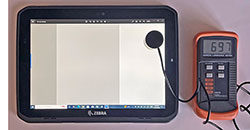 Zebra is one of the few that offers high resolution in rugged tablets. The company did that with their smaller ET5x tablets that have exceptionally high resolution, up to 2560 x 1600 pixel. The ET8x series doesn't go quite that high, but its 2160 x 1440 resolution still beats the rugged tablet competition which generally is still at the lower 1920 x 1080 standard. That means the ET8x series offers 50% more pixels, and that can make all the difference.
Zebra is one of the few that offers high resolution in rugged tablets. The company did that with their smaller ET5x tablets that have exceptionally high resolution, up to 2560 x 1600 pixel. The ET8x series doesn't go quite that high, but its 2160 x 1440 resolution still beats the rugged tablet competition which generally is still at the lower 1920 x 1080 standard. That means the ET8x series offers 50% more pixels, and that can make all the difference.
Display brightness, of course matters in rugged tablets that are often used outdoors. While the luminance of consumer laptops rarely exceeds 250 nits and consumer tablets are generally in the 500 nits range, Zebra lists the ET8x series at 800 nits. We measured 706 nits — probably due to transmission losses in the touch screen layers — but that's still good. However, some of the rugged tablet competition is now in the 1000 to 1200 nits range.
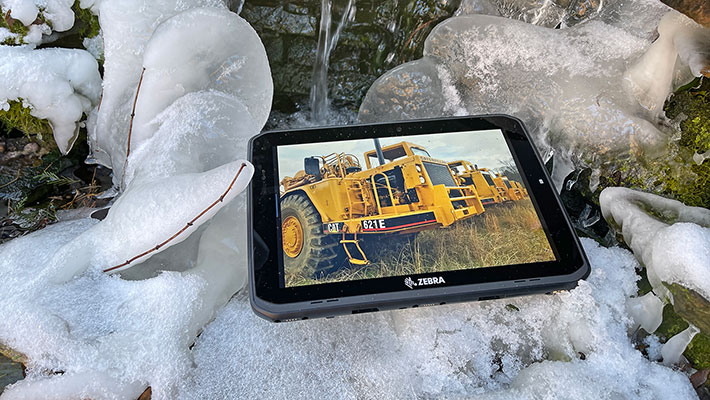
Back in the day, we saw substantial differences in display quality and viewability from brand to brand and model to model. That's no longer the case. There may still be small differences but, by and large, all Tier One vendor products have good displays now.
That said, as good as today's display technology is, there are still limitations. Almost all tablets and laptops use "glossy" displays today, and the ET8x is no different. Glossy displays look great, colors "pop," and they work well under most lighting conditions. The problem is with outdoor reflections. Since it's a near universal issue with mobile electronics today, we've all learned to live with it.
The four pictures below show our review ET85 outdoors on a sunny East Tennessee January afternoon. The sequence shows how tilting the tablet so that it is no longer shaded introduces reflections, and how facing the sky makes it appear less bright and some contrast gets lost. A stronger backlight would help a bit, but at the cost of precious battery life.
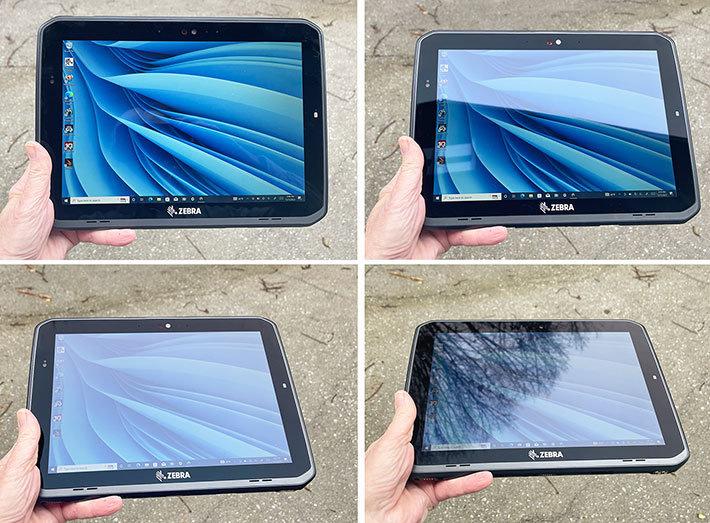
Another problem LCD screens used to have was narrow viewing angles — the image would look good from head-on, but viewing it from angles would result in color and contrast shifts. That's rarely the case anymore today, and viewing the ET8x display from just about any angle doesn't diminish or change the picture.
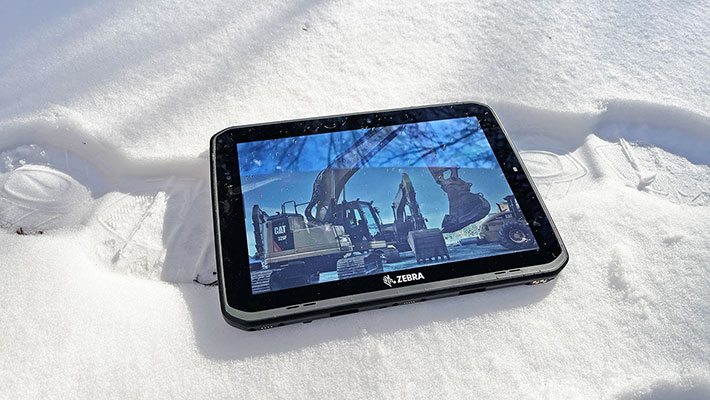
As far as the touch screen goes, it's, of course, capacitive multi-touch that can handle ten separate inputs. Unlike the smaller ET5x, the ET8x tablets does have an active digitizer option for those who like to use a MPP 2.0 compatible pen (which needs a battery). The touch screen itself has glove and wet modes, and with capacitive multi touch it's always nice to have a flush bezel area that goes beyond the LCD perimeter. That makes multi-touch so much easier and also keeps the tablet from misinterpreting just holding it for a touch operation (as is all too common with consumer phones and tablets).
Dual cameras
Like most modern tablets, the Zebra ET8x has both front and rear cameras. On the front is a Full HD Windows Hello auto-focus camera . The rear camera is for picture taking and documentation. It has a 13-megapixel imager with user-controllable LED flash. The pictures we took with the rear camera in its maximum resolution setting came out in 4:3 aspect ratio with 4096 × 3040 pixel resolution, which makes for 12.45 megapixel. 16:9 aspect ratio is selectable as well. We used the cameras in our review unit with the standard Windows 10 Camera application. Both cameras can be used for stills as well as for video.
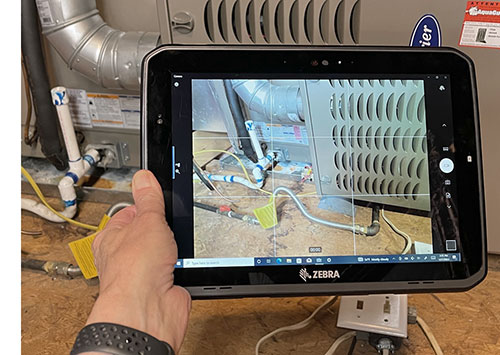 Both cameras have mechanically operated privacy shutters. This guards against either hackers or apps taking images through the tablet's cameras. These days one cannot be too careful.
Both cameras have mechanically operated privacy shutters. This guards against either hackers or apps taking images through the tablet's cameras. These days one cannot be too careful.
Based on past experience with most cameras integrated into rugged mobile computing gear, our expectations were modest, especially when using the very basic Windows Camera app. For once, we were positively surprised. The cameras integrated into the ET8x series are significantly better than average. Unfortunately, the very basic Windows Camera app simply cannot do the cameras justice.
While the Camera app settings are limited and, for example, won't allow image settings other than just the aspect ratio, users can opt for manual input in white balance, ISO, shutter speed, flash and exposure compensation. There's even manual focus, something we don't see often in Windows cameras. There are, however, only four still picture resolutions available, those being 640x480, 1280x720, 1920x1080 and 4096x3040. For video, options are 480p, 720p, 1080p and 3040p.
What that means is that the ET8x cameras can be used for documentation on the job. That should be a given (why else include cameras?), but most such cameras don't even come close to replacing a dedicated camera or a smartphone. So kudos to Zebra for doing better. With some practice, these cameras can be used on the job. We just wish Zebra would source their own camera app.
The pictures below were shot with the ET85 rear camera in its highest resolution setting that uses a 4:3 aspect ratio mode. The sample pictures are a mix of tasks that a field service professional may encounter on the job, and some of the flora around our offices. Click on the image to bring up a full-size version.
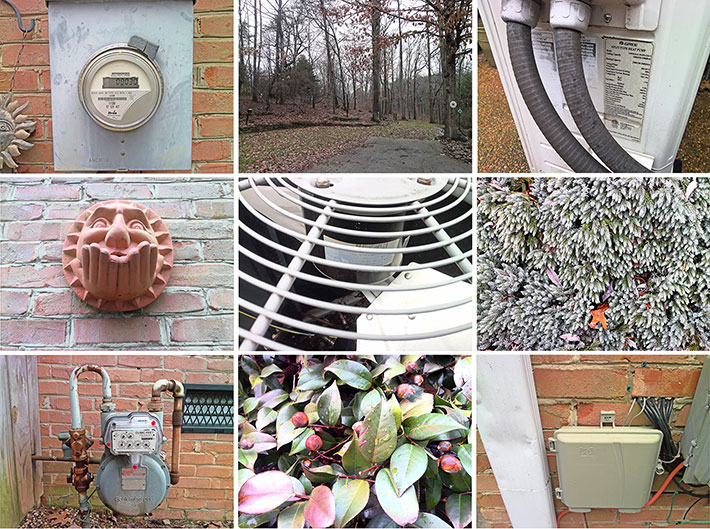
Video, too, is better than what we've seen from many cameras integrated into rugged devices. The camera generally doesn't fall behind and the maximum 3040p recording format is very sharp, even at just 30 frames per second. Here again, more options from the Camera app would greatly help.
Bottom line on the cameras: good hardware that very much deserves much better software than the standard Windows Camera app.
Remarkably rugged
Ruggedness isn't easy to define. There aren't any binding governmental or industry requirements describing what "rugged" is and how rugged something is to be. And even the ruggedness tests described in the various military standards can be vague and subject to interpretation.
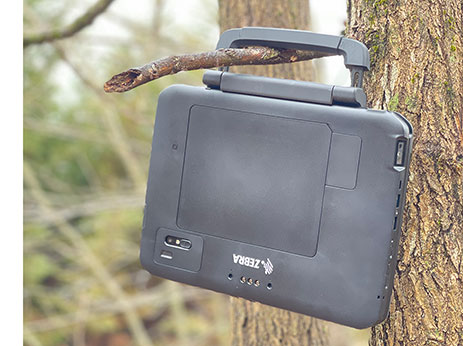 In general, tablets and laptops made for use on the job and in challenging environments have a certain look and design language that instantly communicates their purpose. That look can be minimalist or utilitarian, or invoke military or industrial use via colors, protective bumpers or other prominent reminders as to what they are for.
In general, tablets and laptops made for use on the job and in challenging environments have a certain look and design language that instantly communicates their purpose. That look can be minimalist or utilitarian, or invoke military or industrial use via colors, protective bumpers or other prominent reminders as to what they are for.
Zebra doesn't do that. Zebra design almost always follows function, but with a look aimed as fitting in rather than standing out. The degree of durability and resistance to potential damage on the job is inherent in the design, baked in rather than prominently displayed.
There are, of course, certain ruggedness tests and certifications that customers expect from such products. If drops, vibration, exposure to the elements and other harmful events are likely to occur on the job, the product must be designed to handle those without failing or needing repair. Zebra knows their customers, knows what challenges equipment will encounter, and then makes sure their gear can handle it.
The ET8x series spec sheets contains a User Environment section that describes how the tablets stand with regard to operating temperature and storage temperature; thermal shock; humidity; getting dropped; protection against vibration, electrostatic discharge, solar radiation, fluid contamination; what cleaning and disinfecting agents they can handle, if they can be used in hazardous locations, and what kind of certifications they comply with or have been certified for.
Not all ruggedness criteria apply to all deployments and all customers. Some may apply to only a few or none. That's why it's important to have hard, easy to understand ruggedness information on areas that matter. Tablets almost certainly will get dropped at some point. So it's good to know that the ET8x series passed the MIL-STH-810H drop test (see our take on the test) from four feet. If more is needed, the optional protective boot raises that to five feet. But it's just three feet if the tablet is used with the optional keyboard.
Devices like the ET8x may also be subjected to vibration, especially if used in vehicles. Testing for that is commonly done in accordance with the MIL-STD-810H, Method 514.8, and Zebra did that, operating and non-operating.
Dust and liquids can destroy electronic devices, and therefore must be protected against both. The ET8x series carries an IP65-level of ingress protection. The "6" means complete protection against dust, and the "5" means protection against low pressure water jets from all directions. What that means, is that the tablet can handle any degree of rain, but it shouldn't be hosed down with a pressure washer or submerged into water.
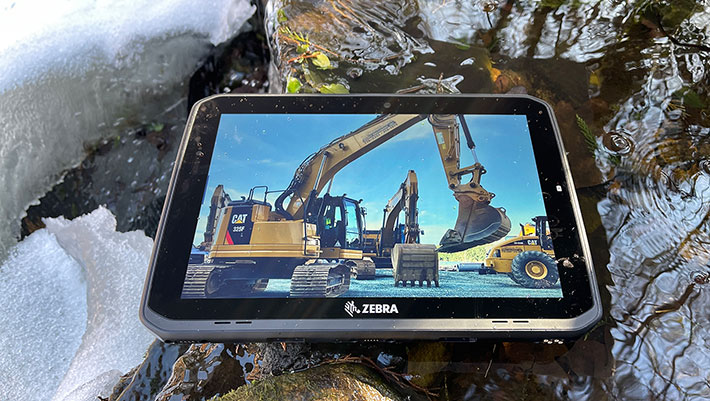
The allowable operating temperature range is important because tablets like the ET8x may encounter a very wide range of operating conditions, from freezers to deserts. Here, the ET8x can handle -4 to 140 degrees Fahrenheit (-20 to 60 centigrade), good enough for virtually all conceivable operating environments, including commercial freezers.
One thing that's somewhat unique about the ET8x is that the tablets do not have protective port covers. That may raise eyebrows, because virtually all rugged devices do have them. Since the ET8x series has IP65 protection without protective doors, the lack of covers can be a plus because protective port covers can be a pain to open and securely close. If a customer doesn't feel comfortable without covers, the optional protective boot does serve as a port cover as well.
Apart from the listed specs, our examination of the ET8x revealed sturdy, common sense design and construction. And unlike far too many rugged devices that use materials that scratch and dent easily, the ET8x's industrial plastic body looks it can handle a lot of abuse. Relatively low weight for a rugged device also helps the ET8x to be less damage-prone on impact than heavier devices. One thing that would be nice on the options list would be bolt-on protective corner guards.
Summary: The Zebra ET8x Rugged 2-in-1 Tablet
Business and enterprise customers often find themselves in a difficult position. Consumer tablets are inexpensive, staff knows and likes them, and the lure of the low initial acquisition cost can be strong. But it's rarely the best way to go. Even with protective cases, consumer tech is unlikely to hold up in the long run, resulting in downtime, replacements and repairs. It's really better to get something that's built for the job, and the ET8x Rugged 2-in-1 Tablet is just that.
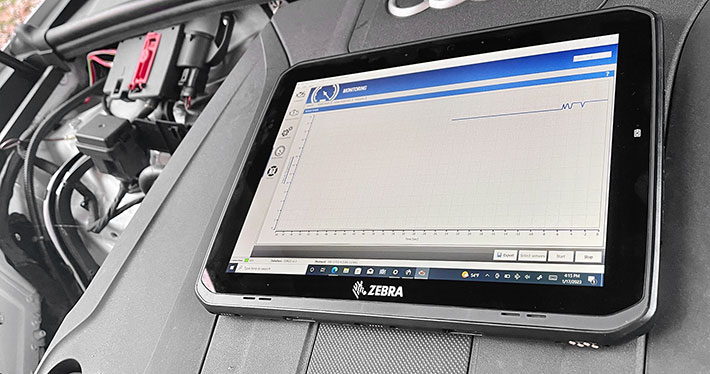
To recap, the Zebra ET80 and ET85 are rugged 2-in-1 tablets with big 12-inch capacitive multi-touch displays with 3:2 aspect ratio and higher resolution than the competition. An active pen is optionally available for those who need that functionality. The sole difference between the ET80 and the ET85 is that the latter comes with 5G WWAN and GNSS.
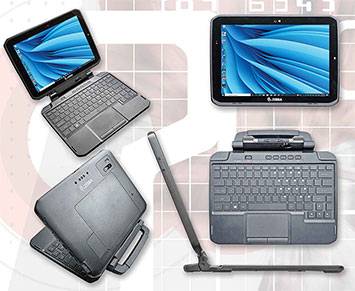 The ET8x tablets are just 0.6 inches thick and weigh under three pounds. They have above average cameras (Full HD front, 13mp rear, both with mechanical privacy covers), can be equipped with an integrated Zebra SE4107 2D scanner, have two USB-A ports and one USB-C port, dual speakers and four microphones.
The ET8x tablets are just 0.6 inches thick and weigh under three pounds. They have above average cameras (Full HD front, 13mp rear, both with mechanical privacy covers), can be equipped with an integrated Zebra SE4107 2D scanner, have two USB-A ports and one USB-C port, dual speakers and four microphones.
Zebra offers the fanless and thus silent tablets with three 7/15 watt Intel 11th generation "Tiger Lake" processor options that provide good performance. Customers can opt for up to 16GB of RAM and 512GB of fast user-removable, PCIe-based solid state storage.
The optional detachable keyboard, specially designed for the ET8x series, converts the tablets into full-function laptops with a carry handle. Additional functionality comes via bolt-on expansion backs that provide a CAC Smartcard reader, second battery, and rotating hand strap. There is also a wide assortment of accessories for the series, including office and vehicle docks.
Overall, the Zebra ET8x is an impressive combination of performance, functionality, and ruggedness in an ergonomic, slender package that can work as a standalone tablet, a mounted tablet or a laptop.
– -- Conrad H. Blickenstorfer, February 2023
|
Zebra ET80/ET85 Specifications
|
| Status |
Full review 02/2023
|
| Product type |
Rugged 2-in-1 tablet
|
| Processor
|
Quad-core Intel Core i7-1180G7 (4.60GHz max turbo)
Quad-core Intel Core i5-1140G7 (4.20GHz max turbo)
Quad-core Intel Core i5-1130G7 (4.00GHz max turbo)
|
| CPU Thermal Design Power
|
i7-1180G7: 7/15 watts
i5-1140G7: 7/15 watts
i5-1130G7: 7/15 watts |
| OS
|
Microsoft Windows 10 Pro or IoT, Windows 11
|
| Memory
|
8 GB or 16 GB LPDDR4x-4266
|
| Display type
|
Anti-reflective/Anti-Smudge transmissive LCD with Gorilla Glass, night-vision mode, 800 nits luminance (706 nits as tested)
|
| Display size and resolution
|
3:2 12.0-inch 2,160 x 1,440 pixel (216 ppi)
|
| Digitizer/Pens
|
10-point capacitive multi-touch; glove and mode, MPP 2.0 active pen compatible
|
| Keyboard
|
Volume up/down; power on/off; barcode scanner (or customizable)
|
| Storage
|
128GB, 256GB or 512GB tool-less user-removable PCIe SSD |
| Slots
|
ET85 only: 1 x Nano SIM, 1 x eSIM
|
| Temperature
|
-4° to 140°F (-20° to 60°F) |
| Humidity
|
Est: 5-95% non-condensing |
| Vibration
|
MIL-STD-810H 514.8 Composite Wheel;
|
| Enclosure Class
|
IP65 |
| EMI
|
unknown |
| Shock: Transit Drop
|
MIL-STD-810H Method 516.8, Procedure I; 20 g operating, 40 g non-operating
|
| HazLoc
|
C1D2 (tablet and keyboard); rugged boot required |
| Certifications
|
E-Mark Europe 12V system ECE Regulation No.10 Rev 6
|
| Size (inches)
|
12.1 x 8.9 x 0.6 inches (308 x 225 x 16 mm) |
| Weight
|
2.8 pounds (1.3 kg)
|
| Power
|
7.7V 5,180mAH 39.8 watt-hour Li-Polymer battery; opt. hot-swappable 7.6V 3,400mAH 25.8 watt-hour expansion back ("11/17 hours")
|
| Sensors
|
Ambient light, motion, magnetometer
|
| Camera
|
Front: Full HD AF Windows Hello, Rear: 13mp AF w/ flash and mechanical privacy shade
|
| Scanning
|
Integrated Zebra SE4107 scan engine |
| Wireless
|
WiFi 6E, 802.11ax R2, Class 1 Bluetooth 5.2 + Audio LE, 5G LTE, GNSS (GPS, GLONASS, BeiDou/Compass, Galileo), NFC
|
| Interface
|
1 x USB-C USB 3.2 Gen2 (charging, Displayport), 2 x USB 3.2 Gen2 Type A, expansion connector for gigabit LAN and DB9 true serial; 3x antenna pass through, keyboard and docking connectors (dock may have 2 x USB 3.0/2.0 Type A, 2 x USB 2.0 Type A, 2 x HDMI Type A, 3 x gigabit RJ45; power in)
|
Price
|
Inquire
|
| Website
|
Zebra ET80/ET85 product page |
| Brochure
|
 Zebra ET80/ET85 specs Zebra ET80/ET85 specs |
| Warranty
|
3 years
|



